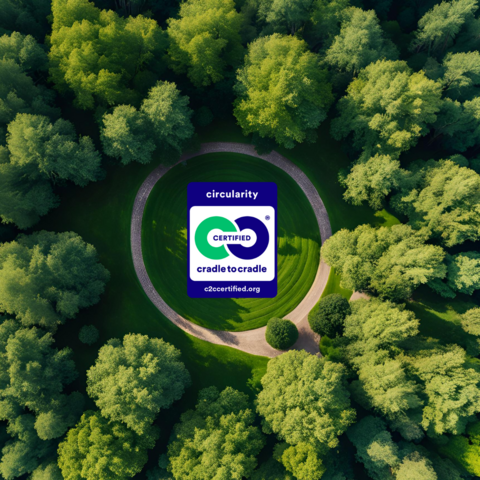News Brief
C2C Launches a New, More Accessible Circularity Certificate
C2C’s new Certified Circularity Standard, derived from the full product standard, is intended to expand manufacturer access to circular product verification. 
C2CPII’s full product standard, Cradle to Cradle Certified Product Standard—now in version 4.1—covers all aspects of product sustainability and is widely considered the “gold standard” for product certifications. It is organized across five categories:
- Material Health
- Product Circularity
- Clean Air & Climate Protections
- Water & Soil Stewardship
- Social Fairness
A product’s C2C certification level—Bronze, Silver, Gold, or Platinum—is determined by its lowest category score. For instance, a product might meet the requirements for Gold in four categories, but if it achieves only Bronze in the fifth category, its overall certification level will be Bronze.
Securing a C2C certification is a very involved process with significant cost. The new Circularity Certificate, like the Material Health Certificate before it, offers a way for manufacturers to meaningfully engage with and receive recognition for circularity work without meeting the requirements of the full certification.
Details and requirements
To receive the Circularity Certificate, a product must meet, at minimum, the Bronze-level requirements of the Product Circularity category in the full product standard. Bronze-level requirements include:
- designating each homogenous material in a product as intended for either the biological or technical cycle.
- defining the cycling pathway for each.
- developing a cycling plan that identifies and addresses barriers to material reuse and recovery.
- incorporating a percentage of cycled and/or renewable content in the product.
- ensuring that 50% of the product by weight is comprised of materials compatible with its cycling pathway.
Silver, Gold, and Platinum-level criteria expand from there. For instance, 99% of a Platinum-level product by weight must be designed for disassembly. (See BuildingGreen’s circularity explainer for a detailed explanation of the topic and its terms.)
Circularity Certified products must also comply with the chemical screening portion of the Material Health category. “At C2CPII we always say, ‘first safe, then circular,’ reflected DeCherney, explaining that after extensive stakeholder discussions, the organization decided that including material health requirements “is in keeping with the Cradle to Cradle design principles that our standard is based on,” which she continued, “emphasize the use of healthy, non-toxic substances as we strive to create a resilient future.” That said, achievement of the Circularity Certificate will not automatically earn products the Material Health Certificate, which requires manufacturers to go beyond screening and complete a material health assessment.
As with the full certification, products that receive the Circularity Certificate will receive a Circularity Data Report and be listed on C2CPII’s product registry. According to DeCherney, the requirements of the Certified Circularity standard will help products stay ahead of existing and upcoming regulations and reporting requirements. For instance, she continued, it may help U.S. “companies meet growing state-level requirements to reduce waste through Extended Producer Responsibility (EPR) policies, recycled content, and recycling requirements.”
Also like the full certification, manufacturers will need to recertify products every three years while demonstrating measurable progress toward the Platinum level of achievement, commented DeCherney.
In a subsequent email, DeCherney clarified that C2CPII is redesigning its certified product registry, where it publishes the generic requirements certified products have met, to display more specific product achievements. This change is in development for early 2025, she said.
Intended users
C2CPII, explained DeCherney, is looking to manufacturers of gypsum, acoustic ceiling tiles and panels, tile, casework, insulation, resilient flooring, carpet, textiles, and furniture as likely initial users within the building industry. In this way, she continued, the standard aligns with other industry initiatives, including the AIA Materials Pledge Reporting Guide, the Gensler Product Sustainability Standard, and the HOK Material Tracker project, that are targeting similar product types.
Companies can begin applying for Certified Circularity now. According to DeCherney, C2CPII expects to begin issuing certificates in early 2025.
“Designers, ask manufacturers about their circularity story and if they are certified,” she encouraged, “your voice matters!”
More on product circularity
Circular Economy: Better Design from Start to … Start
For more information:
Cradle to Cradle Products Innovation Institute
c2ccertified.org
Update: This article was updated on November 12, 2024, to include the logo for the Certified Circularity Standard.
Update: This article was updated on November 21, 2024, to reflect C2CPII's plans to redesign its product registry.
Published November 5, 2024 Permalink Citation
Waters, E. (2024, November 5). C2C Launches a New, More Accessible Circularity Certificate. Retrieved from https://www.buildinggreen.com/newsbrief/c2c-launches-new-more-accessible-circularity-certificate



Add new comment
To post a comment, you need to register for a BuildingGreen Basic membership (free) or login to your existing profile.